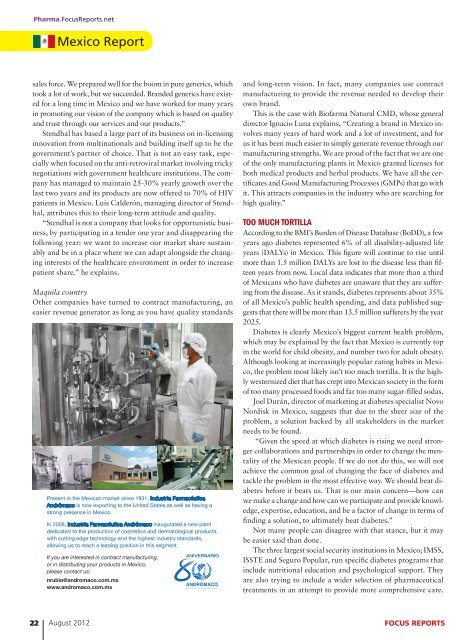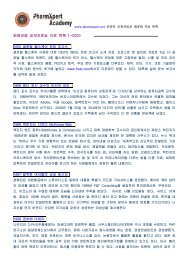Pharma report
Pharma report
Pharma report
Create successful ePaper yourself
Turn your PDF publications into a flip-book with our unique Google optimized e-Paper software.
<strong>Pharma</strong>.FocusReports.net<br />
Mexico Report<br />
Mexico Report<br />
SPECIAL SPONSORED SECTION<br />
sales force. We prepared well for the boom in pure generics, which<br />
took a lot of work, but we succeeded. Branded generics have existed<br />
for a long time in Mexico and we have worked for many years<br />
in promoting our vision of the company which is based on quality<br />
and trust through our services and our products.”<br />
Stendhal has based a large part of its business on in-licensing<br />
innovation from multinationals and building itself up to be the<br />
government’s partner of choice. That is not an easy task, especially<br />
when focused on the anti-retroviral market involving tricky<br />
negotiations with government healthcare institutions. The company<br />
has managed to maintain 25-30% yearly growth over the<br />
last two years and its products are now offered to 70% of HIV<br />
patients in Mexico. Luis Calderón, managing director of Stendhal,<br />
attributes this to their long-term attitude and quality.<br />
“Stendhal is not a company that looks for opportunistic business,<br />
by participating in a tender one year and disappearing the<br />
following year: we want to increase our market share sustainably<br />
and be in a place where we can adapt alongside the changing<br />
interests of the healthcare environment in order to increase<br />
patient share.” he explains.<br />
Maquila country<br />
Other companies have turned to contract manufacturing, an<br />
easier revenue generator as long as you have quality standards<br />
and long-term vision. In fact, many companies use contract<br />
manufacturing to provide the revenue needed to develop their<br />
own brand.<br />
This is the case with Biofarma Natural CMD, whose general<br />
director Ignacio Luna explains, “Creating a brand in Mexico involves<br />
many years of hard work and a lot of investment, and for<br />
us it has been much easier to simply generate revenue through our<br />
manufacturing strengths. We are proud of the fact that we are one<br />
of the only manufacturing plants in Mexico granted licenses for<br />
both medical products and herbal products. We have all the certificates<br />
and Good Manufacturing Processes (GMPs) that go with<br />
it. This attracts companies in the industry who are searching for<br />
high quality.”<br />
TOO MUCH TORTILLA<br />
According to the BMI’s Burden of Disease Database (BoDD), a few<br />
years ago diabetes represented 6% of all disability-adjusted life<br />
years (DALYs) in Mexico. This figure will continue to rise until<br />
more than 1.5 million DALYs are lost to the disease less than fifteen<br />
years from now. Local data indicates that more than a third<br />
of Mexicans who have diabetes are unaware that they are suffering<br />
from the disease. As it stands, diabetes represents about 35%<br />
of all Mexico’s public health spending, and data published suggests<br />
that there will be more than 13.5 million sufferers by the year<br />
2025.<br />
Diabetes is clearly Mexico’s biggest current health problem,<br />
which may be explained by the fact that Mexico is currently top<br />
in the world for child obesity, and number two for adult obesity.<br />
Although looking at increasingly popular eating habits in Mexico,<br />
the problem most likely isn’t too much tortilla. It is the highly<br />
westernized diet that has crept into Mexican society in the form<br />
of too many processed foods and far too many sugar-filled sodas.<br />
Joel Durán, director of marketing at diabetes specialist Novo<br />
Nordisk in Mexico, suggests that due to the sheer size of the<br />
problem, a solution backed by all stakeholders in the market<br />
needs to be found.<br />
“Given the speed at which diabetes is rising we need stronger<br />
collaborations and partnerships in order to change the mentality<br />
of the Mexican people. If we do not do this, we will not<br />
achieve the common goal of changing the face of diabetes and<br />
tackle the problem in the most effective way. We should beat diabetes<br />
before it beats us. That is our main concern—how can<br />
we make a change and how can we participate and provide knowledge,<br />
expertise, education, and be a factor of change in terms of<br />
finding a solution, to ultimately beat diabetes.”<br />
Not many people can disagree with that stance, but it may<br />
be easier said than done.<br />
The three largest social security institutions in Mexico; IMSS,<br />
ISSTE and Seguro Popular, run specific diabetes programs that<br />
include nutritional education and psychological support. They<br />
are also trying to include a wider selection of pharmaceutical<br />
treatments in an attempt to provide more comprehensive care.<br />
S17 FOCUS REPORTS AUGUST 2012<br />
22 August 2012<br />
NDROMACO black yellow magenta cyan QP_1-1.pgs 07.05.2012 04:57<br />
HCL Premedia<br />
FOCUS REPORTS
















